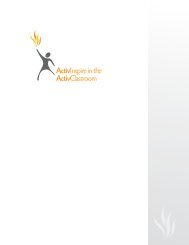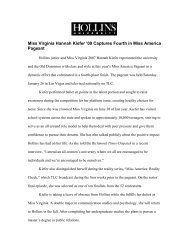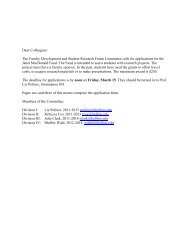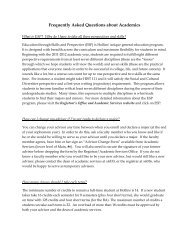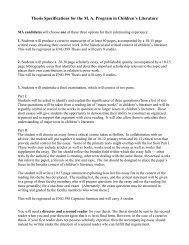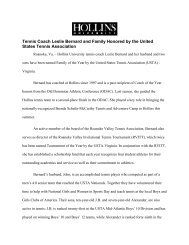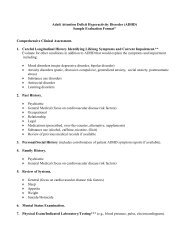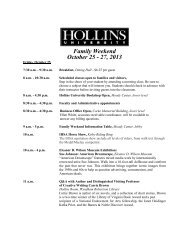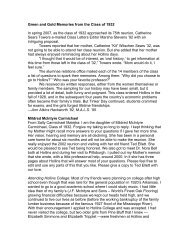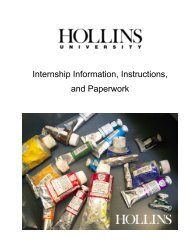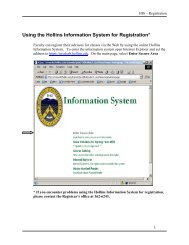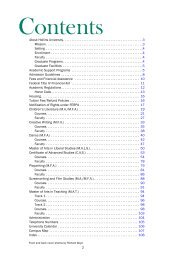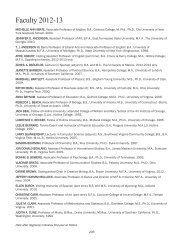ENGLISH & CREATIVE WRITING COURSE DESCRIPTIONS
ENGLISH & CREATIVE WRITING COURSE DESCRIPTIONS
ENGLISH & CREATIVE WRITING COURSE DESCRIPTIONS
Create successful ePaper yourself
Turn your PDF publications into a flip-book with our unique Google optimized e-Paper software.
positive changes that have taken place in the depiction of the black American, and on the need for a similar<br />
evolution in the rendering of Native American, Asian American, and Hispanic American images. Prerequisite:<br />
sophomore standing.<br />
ENG 339: 18TH‐CENTURY BRITISH NOVEL (4)<br />
An examination of the cultural background and early development of the novel in English with some attention to<br />
the sentimental and Gothic genres. Close reading of novels by Samuel Richardson, Henry Fielding, Laurence<br />
Sterne, Tobias Smollett, Fanny Burney, Ann Radcliffe, Matthew Gregory Lewis, and Jane Austen. Prerequisite:<br />
sophomore standing.<br />
ENG 340: SHAKESPEARE AS SCREENWRITER (4)<br />
“Shakespeare,” according to Orson Welles, “would have made a great movie writer.” We shall, in this course,<br />
read and examine a number of Shakespeare’s plays and his collaboration across the centuries with important<br />
filmmakers such as Welles, Roman Polanski, Akira Kurosawa, Kenneth Branagh, Trevor Nunn, Tom Stoppard,<br />
Max Reinhardt, Michael Hoffman, and Stanley Kubrick. Considerable attention will be paid to the nature of<br />
Shakespearean drama and contemporary cinema, as well as the nature of collaboration, translation,<br />
interpretation, and the question of the “purity” of imaginative texts. Plays include Titus Andronicus, Hamlet,<br />
Macbeth, Twelfth Night, A Midsummer Night’s Dream, Othello, and The Merry Wives of Windsor. Also listed as<br />
FILM 340. Prerequisite: sophomore standing.<br />
ENG 342: ADVANCED STUDIES IN CHILDREN’S LITERATURE (4)<br />
Close study of various topics in children’s literature. Recent topics have included the tomboy character and<br />
gender and girls fiction. Also listed as GWS 342. Prerequisite: junior standing or permission; English majors must<br />
have completed both a 100‐level and a 200‐level literature course in English.<br />
ENG 343: THE MODERN NOVEL I (4)<br />
An examination of how the mystery story has become one of the primary literary forms for deconstruction and<br />
reconstruction in the modern novel. After a study of the sources of the form in the Bible, Sophocles, and Poe,<br />
the course moves on to novels by such writers as Agatha Christie, Dashiell Hammett, William Faulkner, Alain<br />
Robbe‐Grillet, Vladimir Nabokov, Chester Himes, and Friedrich Dürrenmatt. Prerequisite: sophomore standing.<br />
ENG 344: THE MODERN NOVEL II (4)<br />
A study of modern British and European novels (in translation), including works by Milan Kundera, Joseph<br />
Conrad, Albert Camus, André Malraux, Christa Wolf, Herman Brock, and others. Prerequisite: sophomore<br />
standing.<br />
ENG 345: ARAB WOMEN WRITERS (4)<br />
This course focuses on the literature of Arab women whose writing engages the political and cultural<br />
transformations taking place in the Middle East. Particular attention is paid to how these writers confront the<br />
restrictions and expectations placed upon Arab women, thus redefining culture, religion, and politics through an<br />
exploration of gender relationships. Issues raised for discussion include Arab women’s struggle for<br />
independence in both domestic and economic spheres, women’s participation in political struggles, and conflicts<br />
between modernization and tradition. Readings include writers from several Middle Eastern countries. Written<br />
requirements consist of a series of short papers and a final creative/critical project. Also listed as GWS 345.<br />
Prerequisite: junior standing or permission.<br />
ENG 346: ARAB‐AMERICAN LITERATURE (4)<br />
Recent events have highlighted the presence of Arabs in the U.S. and increased their exposure as a significant<br />
minority group. These events have also served as a catalyst for Arab‐Americans to explore their identity and to<br />
articulate their unique experiences within the context of American culture. The course begins with an



